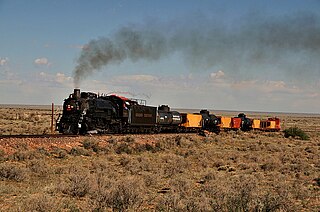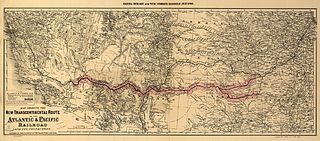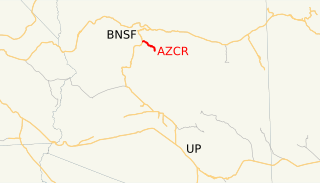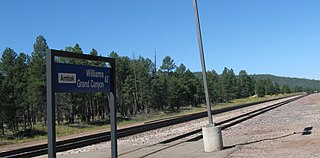Related Research Articles

The Atchison, Topeka and Santa Fe Railway, often referred to as the Santa Fe or AT&SF, was one of the largest Class 1 railroads in the United States between 1859 and 1996.

The Fred Harvey Company was the owner of the Harvey House chain of restaurants, hotels and other hospitality industry businesses alongside railroads in the Western United States. It was founded in 1876 by Fred Harvey to cater to the growing number of train passengers.

The Grand Canyon Railway is a heritage railroad which carries passengers between Williams, Arizona, and the South Rim of Grand Canyon National Park.

Atchison, Topeka and Santa Fe 3751 is a class "3751" 4-8-4 "Heavy Mountain" type steam locomotive built in May 1927 by the Baldwin Locomotive Works in Eddystone (Philadelphia), Pennsylvania for the Atchison, Topeka & Santa Fe Railway (ATSF). No. 3751 was the first 4-8-4 steam locomotive built for the Santa Fe and was referenced in documentation as type: "Heavy Mountain", "New Mountain", or "Mountain 4-wheel trailer". No. 3751 served in passenger duties until being retired in 1953.

The Grand Canyon Limited was one of the named passenger trains of the Atchison, Topeka and Santa Fe Railway. It was train Nos. 23 & 24 between Chicago, Illinois, and Los Angeles, California.

Atchison, Topeka and Santa Fe 2926 is a class "2900" 4-8-4 type steam locomotive built in May 1944 by the Baldwin Locomotive Works for the Atchison, Topeka & Santa Fe Railway (ATSF). It was used to pull passenger and fast freight trains, mostly throughout New Mexico, until it was retired from revenue service in 1953. Three years later, it was donated to Coronado Park in Albuquerque for static display.

The Atlantic and Pacific Railroad was a U.S. railroad that owned or operated two disjointed segments, one connecting St. Louis, Missouri with Tulsa, Oklahoma, and the other connecting Albuquerque, New Mexico with Needles in Southern California. It was incorporated by the U.S. Congress in 1866 as a transcontinental railroad connecting Springfield, Missouri and Van Buren, Arkansas with California. The central portion was never constructed, and the two halves later became parts of the St. Louis-San Francisco Railway and Atchison, Topeka and Santa Fe Railway systems, now both merged into the BNSF Railway.

The Clarkdale Arizona Central Railroad is an Arizona short-line railroad that operates from a connection with the BNSF Railway at Drake, Arizona. The AZCR runs 37.8 miles (60.8 km) from Drake to Clarkdale, Arizona. An excursion train also runs on the line through Verde Canyon and is operated by the same owners under the Verde Canyon Railroad. The AZCR is owned by David L. Durbano.
The Bradshaw Mountain Railroad was a subsidiary of the Santa Fe, Prescott and Phoenix Railway (SFP&P) in Arizona. The 35.65-mile (57.37 km) railroad was built to serve the mines in the Bradshaw Mountains. The railroad built from a connection at Poland Junction and at Mayer with the Prescott and Eastern Railroad. The Prescott and Eastern was also operated by the SFP&P.
The Prescott and Eastern Railroad (P&E) was a non-operating subsidiary of the Santa Fe, Prescott and Phoenix Railway (SFP&P) in Arizona. The 26.4 mile (42.5 km) common carrier railroad was built to serve the mines in the region. The railroad built from a connection with the SFP&P at Entro and extended south to Poland Junction and terminated at Mayer. At Poland Junction and Mayer the P&E connected with the Bradshaw Mountain Railroad, also a non-operating subsidiary of the SFP&P. After various mergers the P&E was merged into the Atchison, Topeka and Santa Fe Railway. The line was later abandoned by the Santa Fe Railway. The first four miles of the line are now the Iron King Trail to Prescott Valley, Arizona.

The Santa Fe, Prescott and Phoenix Railway (SFP&P) was a common carrier railroad that later became an operating subsidiary of the Atchison, Topeka and Santa Fe Railway in Arizona. At Ash Fork, Arizona, the SFP&P connected with Santa Fe's operating subsidiary, the Atlantic & Pacific Railroad mainline, that ran from California to Chicago. The SFP&P's 195-mile (314 km) line extended the Santa Fe Railway south into Phoenix. The SFP&P extended another 100 miles (160 km) to the east from Phoenix to Florence and Winkelman via the Phoenix and Eastern Railroad. The SFP&P also served several mines in the Prescott area, including the Derby Mine by way of the Summit (flag) Station at 'Prieta' in the Sierra Prieta range, through its various subsidiary railroads.

Williams Junction station was an Amtrak train station on the Southwest Chief route, located three miles (4.8 km) southeast of Williams, Arizona in the Kaibab National Forest. The station primarily served passengers travelling to the Grand Canyon via the Grand Canyon Railway.

Williams Depot is a privately owned train station in Williams, Arizona. It is the southern terminus of the Grand Canyon Railway line.

Grand Canyon Depot, also known as Grand Canyon Railroad Station, was constructed in 1909–10 for the Atchison, Topeka and Santa Fe Railway at the South Rim of the Grand Canyon, in what is now Grand Canyon National Park. It is one of three remaining railroad depots in the United States built with logs as the primary structural material. The station is within 330 feet (100 m) of the rim of the canyon, opposite the El Tovar Hotel, also built by the railroad. The depot is designated a National Historic Landmark, is listed the National Register of Historic Places, and is included in the Grand Canyon Village National Historic Landmark District.

Atchison, Topeka and Santa Fe 3759 is a class 3751 4-8-4 "Heavy Mountain" type steam railway locomotive built by the Baldwin Locomotive Works in 1928. It is on display in Locomotive Park, located between Andy Devine Avenue and Beale Street in Kingman, Arizona. The park was established in August 1957 with AT&SF 3759 donated to the City of Kingman in recognition of Kingman's history with the railroad. The locomotive is termed a Mountain type on the nearby information plaque, and also in the city's descriptive material which is correct for the Santa Fe. ATSF 4-8-4s were referenced in documentation as type "Heavy Mountain", "New Mountain" or "Mountain 4-wheel trailer."

The Southern Transcon is a main line of the BNSF Railway comprising 11 subdivisions between Southern California and Chicago, Illinois. Completed in its current alignment in 1908 by the Atchison, Topeka and Santa Fe Railway, when it opened the Belen Cutoff in New Mexico and bypassed the steep grades of Raton Pass, it now serves as a mostly double-tracked intermodal corridor.

The Fort Worth and Rio Grande Railway, chartered under the laws of Texas on June 1, 1885, was part of a plan conceived by Buckley Burton Paddock and other Fort Worth civic leaders to create a transcontinental route linking New York, Fort Worth, and the Pacific port of Topolobampo, which they believed would stimulate the growth and development of southwest Texas in general, and the economy of Fort Worth in particular.

Atchison, Topeka and Santa Fe No. 769 is a preserved 769 class 2-8-0 "consolidation" type steam locomotive originally built by the Richmond Locomotive Works in 1900 as one of the Santa Fe Pacific Railroad's final locomotives. It was originally numbered 266 before the SFP had completely merged into its parent company, the Atchison, Topeka and Santa Fe Railway, and the locomotive was renumbered 3045, and it was eventually renumbered again to 769. The locomotive was put into use for short-distance freight trains and for yard switching before being sold again in 1950 to the Albuquerque and Cerrillos Coal Company in Madrid, New Mexico for more yard switching and short distance coal trains. As the 1950s progressed, however, the company shut down due to bankruptcy, and No. 769 was abandoned along with the rest of the locomotive yard and the rest of Madrid. In the late 1970s the town was recovered and converted into a heritage town, and No. 769 was then put on static display just behind the shed it was stored in, which was converted to the Engine House Theatre. In early 2020, No. 769 was selected for a future project to restore it to operating condition to eventually run on reconstructed trackage between Madrid and a nearby BNSF interchange near Los Cerrillos.
The Blackwell and Southern Railway ("B&SR") constructed a rail line running from Braman, Oklahoma to Tonkawa, Oklahoma. The 15.95-mile (25.67 km) route was built in 1899, and sold to the Atchison, Topeka and Santa Fe Railway (AT&SF) in early 1900.
The Kansas, Oklahoma Central and Southwestern Railway (“KOC&S”) was a railroad which in 1899 built tracks from a point near Caney, Kansas to what became Owasso, Oklahoma. After foreclosure in 1900, it was absorbed into the Atchison, Topeka and Santa Fe Railway (“AT&SF”).
References
- Ribokas, Bob (2002). "Grand Canyon Railway". Grand Canyon Explorer. kaibab.org. Retrieved April 1, 2006.
- Robertson, Donald B. (1986). Encyclopedia of Western Railroad History: The Desert States: Arizona, Nevada, New Mexico, Utah. Caldwell, Idaho: The Caxton Printers. p. 88. ISBN 0-87004-305-6.
- Walker, Mike (1995). Steam Powered Video's Comprehensive Railroad Atlas of North America – Arizona & New Mexico. Kent, UK: Steam Powered Publishing. p. 9. ISBN 1-874745-04-8.